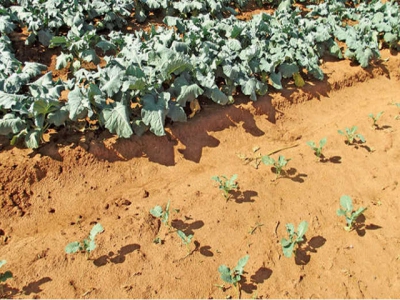Sandy soil: a guide to working with it

Vegetable expert Bill Kerr discusses how to get the best out of sandy soil, regardless of what crop you’re growing.
Provided you manage the fertiliser carefully, healthy crops can be grown in sand. Photo: Bill Kerr
Sandy soil is often called ‘light soils’ because they are relatively ‘light’ or easy to work with when it comes to ploughing, planting and cultivating.
But they’re certainly not ‘light’ or easy to manage! These soils tend to dry out quickly. However, some sandy soils lie on a rocky layer and so can become waterlogged after a lot of rain. In this case, you’ll need drainage trenches.
Other sandy soils have a clay or loam base, which is only discovered when digging holes to determine the soil profile.
Such soils can be highly productive as the heavier soil below can trap leached nutrients and hold moisture. Sandy soils have very little clay to retain nutrients and so are not fertile.
Growing vegetables in sand is similar to farming with hydroponics, where the crops are planted in gravel or some other medium and all the nutrients are supplied via the irrigation water.
With hydroponic farming, however, the water containing the nutrients is circulated. In sandy soil, the nutrients are washed through the soil and mostly lost. To manage this, the golden rule is ‘less, more often’.
Because sand dries out quickly, apply less water more often. With fertiliser, too, give lighter, more frequent applications to allow the roots to take up the nutrients before these are lost.
Organic fertiliser, such as compost, helps with this process. This ‘holds’ any other fertilisers that you apply.
Then, as the compost decomposes, it gradually releases nutrients through the activity of soil organisms. This is called ‘mineralisation’, and it’s usually the most practical way to fertilise sandy soils.
In general, it’s difficult to build up the organic content of sandy soils, especially in warm areas. To achieve the best results, apply the golden rule: smaller quantities of organic matter more often.
Grass mulch also helps to fertilise the soil, as well as keeping it cool in hot weather and reducing weeds.
Loss of nutrients
Leaching of nitrogen can cause serious health problems for your plants, and should be addressed with organic fertiliser.
Loss of calcium can also produce poor results as it causes acid soils, especially in high-rainfall areas; apply agricultural lime to these soils from time to time.
Your fertiliser agent or extension officer can advise you on the quantity needed. Organic fertilisation also helps to produce better crops in acid soils.
Eelworm can be a problem in sandy soils, so it’s a good idea to rotate crops with crops that are not susceptible to this serious pest.
Despite these difficulties, all vegetables can be grown in sandy soil. In fact, this type of soil can be extremely productive if you use the right management methods.
Coming to terms with soil
Simply put, soil, the medium in which rooted plants grow, is a mixture of solids, water and air. The solids include minerals, tiny rock particles, organic matter from animals and plants, and minute living organisms.
As explained previously, there are three basic soil types – sandy, loam and clay. However, most lands have a variable mixture of these, such as ‘sandy loam’ – soil that’s part sand, part loam.
The ideal way to grow vegetables is to conduct market research to decide on what crops are in demand, then find a piece of land with the best possible soil for the crop.
In the real world, however, most farmers and gardeners have to learn to work with the soil they have and make the most of it.
Drainage ditches
The most efficient drainage system – one that allows you to drain the biggest area – is the fishbone pattern. As the name suggests, this consists of channels joining a central ditch at about a 45° angle.
The number of channels and the length of the ditch will be determined by the size of the area under cultivation. Make sure the channels and ditch are angled correctly to carry the water in the right direction.
The channels which guide the water into the central ditch and the ditch itself are filled with rocks, covered with plastic (old fertiliser bags can be used), and filled with soil.
This makes the system almost invisible and you can cultivate the land as normal, even over the channels. You can even build a dam to collect the water that flows out of the central drainage ditch.
Soil profile
If you dig a deep hole in your soil, you’ll notice various layers. These so-called ‘horizons’ differ in texture, structure, colour, ability to hold water and so on, and make up the soil profile.
The surface layer, which contains grass or plant life, is the ‘O’ horizon. The two layers immediately below this – the ‘A’ and ‘B’ horizons – are regarded as the ‘true soil’, as most of the chemical and biological activity that helps plants grow takes place there.
Related news
 Growing a variety of soil microbes
Growing a variety of soil microbes Most farmers are aware that a healthy population of soil organisms is a good thing. What many don’t understand is that the number of soil organisms is directly
 Getting nozzle size and pressure right
Getting nozzle size and pressure right As pointed out previously, the key to successful pest and disease control is optimal penetration of the spray mixture.
 Using a knapsack sprayer on a big farm
Using a knapsack sprayer on a big farm Many farmers think that using a knapsack sprayer is taking a step backwards as large spray rigs are fast and effective. However, knapsack sprayers still have